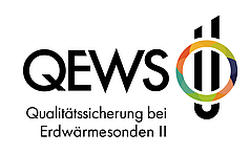QEWS II
Quality Assurance of Borehole Heat Exchangers II
Subject
- Geothermal energy
Task
- Research
- Development
- Knowledge transfer
Funding
- Public funds
Period
04/2016 – 03/2020 (4 years)
Budget
490,000 EUR
Description
The technology of borehole heat exchangers (BHE) is often used as a source for heat pumps for heating systems, as a heat sink for cooling systems as well as a heat storage. Both heating and cooling can be combined for a more efficient operation of the BHE-system. Since the heat energy supply from the underground is nearly infinte, shallow geothermal plants can contribute very well to a sustainable energy mix.
Installing BHE-plants is a complex intervention into the ground, so concerns about the integrity of these plants are still available. Therefore, quality assurance in all periods is needed – from the planning phase until the commissioning. In this project important aspects from a technical as well as from an economic and ecological point of view are examined.
Client
Federal Ministry for Economic Affairs and Energy in Germany (BMWi)
Partner
- Steinbeis Research Institute Solites (DE)
- Bavarian Center of Applied Energy Research (ZAE Bayern) (DE)
- Universitiy of Applied Sciences Biberach – Institute of Buildings and Energy Systems (DE)
- Karlsruhe Institute of Technology (KIT) – Institute of Geography and Geoecology (DE)
- European Institute for Energy Research (EIFER) (DE)
- enOware GmbH (DE)
- Burkhardt Geological und Hydrological Boring GmbH & Co.KG (DE)
Aim
In this research project, questions resulting from damages from earlier failures in BHE plants which led to massive problems are investigated. Subsequently, solutions will be developed.
Implementation
The project is divided in six parts with different focuses. Every joint research partner is working on an own subject.
Solites reveals a better understanding of the grouting process inside the borehole and how the quality of the backfilling of the boreholes after inserting the probes can be improved. For this purpose, the effects of pressure and filtration on the composition of the backfilling material und the formation of holes inside the backfilling are examined in real scale experiments.
Furthermore, it is investigated whether using a vibrator which is often used for concrete leads to an improved backfilling quality.
On basis of a better knowledge about the processes inside the borehole and of the experimental data, first simulations about the backfilling and hardening of the grouting material shall be carried out.
Results
Using the vibration technology does not show a significant improvement of the backfilling quality.
The experiments about the filtration behaviour of the backfilling material are in process. First results do show an improvement of the backfilling quality in regard to former projects.







Downloads and links
www.qews2.de
www.eifer.uni-karlsruhe.de
www.agw.kit.edu
www.mpa-karlsruhe.de
www.zae-bayern.de
www.hochschule-biberach.de
Contact
Tim Lutz
lutz@solites.de
Yannick Reduth
reduth@solites.de
This project has received funding from

The sole responsibility for the content of this webpage lies with the authors. It does not necessarily reflect the opinion of the funding organization. Neither the funding organization nor the author are responsible for any use that may be made of the information contained therein.